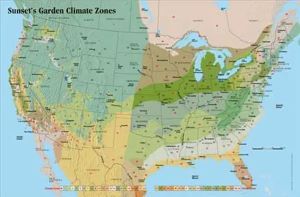By Jeanne Yacoubou, MS
In Components 1 and a couple of of our collection on local weather meals, The Vegetarian Useful resource Group launched perennial greens and prompt basic strategies to develop a perennial backyard. On this article, we’ll assist you choose perennials that may most certainly do nicely in your specific scenario.
Past USDA hardiness zones: sundown local weather zones
The USDA Plant Hardiness Zone Map is the usual method gardeners resolve whether or not a sure species will do nicely of their yard. It’s primarily based on “the typical annual excessive minimal winter temperature.” You establish your zone by zip code.
Nonetheless, this methodology has restricted usefulness as a result of it’s solely involved concerning the temperature at which a plant could possibly be killed by frost. It doesn’t think about all of the elements concerned in permitting a plant to thrive.
The Sundown Local weather Zone system is a extra strong measure to determine if a plant species will do nicely in your yard. This ranking takes into consideration:
- Size of rising season
- Timing and quantity of rainfall
- Winter low temperature
- Summer season excessive temperature
- Wind
- Humidity
- Solar publicity
Initially designed for gardeners on the West Coast, the Sundown system now covers the whole nation.
When researching one of the best perennial greens in your yard, search for Sundown zone info to maximise your success. Eric Toensmeier’s guide, Perennial Greens, on which the next suggestions are primarily based, is a superb supply for Sundown details about unusual perennials.
Finest perennial greens for the Rocky Mountain states, northern plains, and Canada (USDA zones 1-3, Sundown zones 1, 44, 45)
It might be extraordinarily chilly and snowy for lengthy durations, however herbaceous vegetation and roots do amazingly nicely snuggled beneath insulating snow. These are your greatest bets:
- Sorrel
- Good king Henry
- Groundnut
- Arrowhead
- Rhubarb
- Sunchoke
- Ostrich fern
- Watercress
Finest perennial greens for the mid-Atlantic, Northeast, and Midwest (USDA zones 4-7, Sundown zones 2-4, 6, 11, 32-43)
Most perennial greens are from tropical international locations however develop nicely in areas that usually have chilly – however not frigid – durations in winter. Including a thick (6-12 in.) layer of mulch across the base of vegetation helps defend them throughout chilly spells in these comparatively temperate areas.
Alternatively, rising perennials as annuals will keep their productiveness through the years. As an example, you’ll be able to retailer edible roots or tubers in a cool (35-500F), darkish basement or storage identical to you do with potatoes. Take cuttings from herbaceous vegetation and hold them inside as houseplants over the winter, returning them exterior in spring. Place them subsequent to a window or beneath full-spectrum lights.
For vegetation which are very delicate, resembling chaya, you could completely develop them in a container that you simply place exterior in the course of the spring and summer season however carry inside for the winter.
Lastly, for perennial timber and woody shrubs with edible leaves whose above-ground elements die after the primary frost however the place the bottom gained’t freeze, they’ll resprout new progress the next spring. These species – known as dieback perennials – embrace chaya, katuk, moringa, and cranberry and edible hibiscus.
For gardeners on this space of the nation, the next tables record the perennials that may be grown as annuals.
Species that may overwinter inside from cuttings:
- Katuk
- Okinawa spinach
- Perennial cucumber
- Tree collards
- Sissou spinach
Species that may overwinter indoors as tubers:
- Achira
- Chinese language arrowhead
- Oca
- Ulloco
- Water chestnut
- Yacon
Perennial greens that may be began from seed as annuals:
- Cache bean
- Cranberry hibiscus
- Lablab bean
- Malabar spinach
- Runner bean
For extra info on strategies used to develop perennials in chilly areas, see the books Palms Received’t Develop Right here and Different Myths by David Francko and Scorching Crops for Cool Climates by Dennis Schrader and Susan A. Roth.
Finest perennial greens for the recent and humid Southeast (USDA zones 8-9 and Sundown zones 26-28, 31)
Having originated from tropical areas, most perennials thrive within the Southeast. Bananas and chayote are prime examples. You could possibly additionally domesticate yams, katuk, and perennial beans as dieback perennials. Rising taro on this space is straightforward.
Finest perennial greens for the recent and arid Southwest (USDA zones 8-10 and Sundown zones 10, 12, 13, 29, 30)
Just like the Southeast, the Southwest U.S. is right for rising most perennial greens. Moringa timber and chaya shrubs are excellent candidates for dieback perennials due to their edible leaves, becoming a member of the spineless nopale cactus often grown in gardens of this area. The drought-loving, 7-year lima bean is one among a number of perennial beans that thrives right here. A number of species of fruiting cacti, in addition to pomegranates and mesquite, spherical out perennial gardens within the Southwest.
Key takeaways on perennial vegetable choice
Of the 100+ perennial vegetable species, there are certain to be a number of that may thrive beneath virtually any climatic situation. Some others could also be tailored to zones when grown as annuals or dieback perennials. To find out which might be greatest suited in your backyard, analysis your choices earlier than planting.


